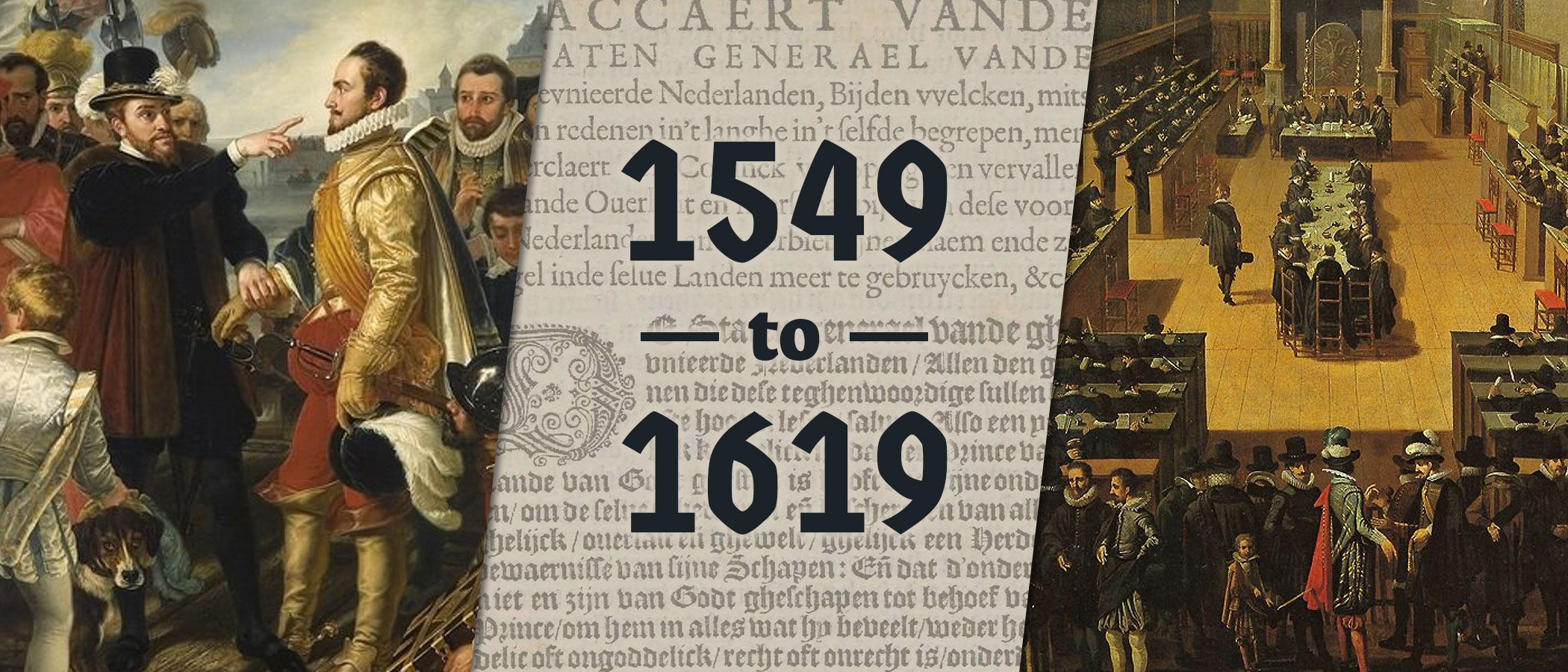Categorizing the past into distinct blocks of time is difficult – and often controversial. So it is for the Low Countries in the era I study, particularly so when I’ve branded my work under the moniker “Renaissance Netherlands” Where “Early Modern Low Countries” would be a much more academically-stringent term, it’s also the name of a very nice journal, so there’s that.
Contents
Renaissance vs. Early Modern
Clarifying What Has Largely Been an Academic Debate
My Focus: 1549 – 1619
From the Unification of the Low Countries to the Birth of the Dutch Golden Age
Historically, the Low Countries were a mish-mash of territories, rulers, cultures, and laws.
- 1549: Charles V, Holy Roman Emperor, King of Spain, and inheritor to the old Burgundian lands, completes what his father began in becoming ruler of all the Low Countries. Sovereignty in hand, he moves forward with their legal settlement and reorganization. This begins in 1548 with the Transaction of Augsburg, and is completed a year later with the Pragmatic Sanction of 1549, which unifies the region as the Seventeen Provinces, a united realm solely inheritable by the heir of Charles V and his descendants.
- 1556: In poor health, Charles V abdicates the throne. His son Philip II becomes king of Castile & Aragon and ruler over the Seventeen Provinces of the Low Countries. His ardent Catholic faith, foreign Spanish identity, and push for centralizing administration of his realm would soon fan the flames of rebellion.
- 1566: The first great signs of revolt come with the summer’s Beeldenstorm (Dutch for “image storm”), a wave of iconoclastic riots targeting churches across much of Brabant, Flanders, Zeeland, and Holland. Open revolt would soon follow, which would be crushed in a year’s time by the arrival of the Duke of Alba and his ruthless “Council of Blood.” Yet the unrest could not be quelled.
- 1576: Years of battles, sieges, and mutinying soldiers – including the recent “Spanish Fury” of the sack of Antwerp which left 7,000 civilians dead – have brought the Seventeen Provinces together to find peace. The result is the Pacification of Ghent, which calls for the removal of foreign soldiers from the Low Countries and the return of the moderate Catholic religious situation before the Revolt. The peace is not to last, with hardline Protestant provocateurs enflaming tensions in Brabant and Flanders. Rival alliances form – the Unions of Arras and of Utrecht – and war breaks out soon again.
- 1588: Robert Dudley, the Early of Leicester departs the Low Countries after clashing with the States General and proving ineffectual, militarily. Never again would the nascent Dutch state look for a “prince” to rule over them. Ideas of a purely republican government begin to take root.
- 1592: Alexander Farnese, the Prince of Parma, has been the Dutch rebels’ supremely challenging foe for over a decade. His military talent combined with his magnanimous statesmanship brought the Dutch nearly to the brink of defeat. But with war with France looming, Philip orders Parma south in 1590, creating an opening for the maturing Dutch under the leadership of Maurice of Nassau to reverse the losses. Parma dies in 1592, Spanish leadership is thrown into temporary disarray, and the Dutch are never so seriously threatened for the remainder of the war. The Republic survives!
- 1619: After years of cultural tension between the humanist and Reformed Protestant elements of society, the Synod of Dort concludes with the hardline Counter-Remonstrants claiming victory – and the additional political effect of Prince Maurice of Nassau becoming the primary political power in the Republic.
Note that when it comes to specific details and dates needed for living history purposes, either for a persona or for material goods, I keep a tighter focus. I try to have all my clothing and kit documentable to the last quarter of the Sixteenth Century, 1575-1600.
The Outer Margins: 1477-1672
The Earliest Northern Renaissance to the Twilight of the Golden Age
Beginning with the twilight of the Burgundian state and the era of Erasmus, then moving through the heights of the Golden Age that ended in geopolitical defeat. Sometimes I’ll reach out to these margins to provide context to the story of the Low Countries – or, simply, if I find an object or historical detail that’s too interesting to not share.
Key Early Dates
- 1477: After the death of Charles the Bold at the Battle of Nancy, his only child Mary of Burgundy is formally recognized as the inheritor of the vast territories of the Burgundian state. She then weds the future Emperor Maximilian I of the powerful Habsburg family of Austria.
- 1512: Acting as steward and regent for his young son, the future Charles V, Maximilian I unites his holdings in the Low Countries by creating the Burgundian Circle at the Diet of Cologne. Both father and son would spend significant time and treasure over the next forty years to expand their control over the rest of the Netherlands.
- 1536: Erasmus of Rotterdam, widely considered one of the greatest scholars of the Renaissance Era, dies unexpectedly in Basel, Switzerland from dysentery. He had been preparing to move back home to Brabant.
Key Latter Dates
- 1648: The Peace of Münster brokered between the Dutch and the Spainish brings the Eighty Years War to an end and recognizes the legal (de jure) independence of the Republic.
- 1669: Celebrated painter Rembrandt Harmenszoon van Rijn dies in poverty (after a lifetime of living beyond his means and bad investments). He was given a pauper’s funeral and buried in an unmarked, church-owned grave in Amsterdam’s Westerkerk.
- 1672: The Republic suffers through the Rampjaar, or “Disaster Year,” when English, French, and German forces conquer Dutch territory and inflame political tensions.
